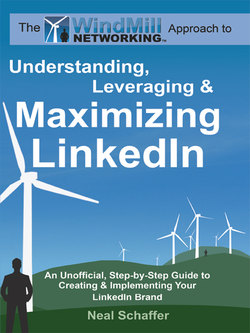Читать книгу Windmill Networking: Understanding, Leveraging & Maximizing LinkedIn - Neal Schaffer - Страница 9
На сайте Литреса книга снята с продажи.
An Introduction to LinkedIn
ОглавлениеWith 40 million primarily professional members, LinkedIn is by far the biggest social networking site that caters to the professional demographic. There are other social networking sites, such as MySpace and Facebook, that have several times more members; however, their targeted demographic differs from LinkedIn (albeit Facebook is slowly changing).
The concept behind LinkedIn is very simple: Professionals put up their profiles and “connect” with people they know. I will explore this idea later in the book more closely; for now, note that LinkedIn clearly states that they only want you to “connect” with people you know. On the other hand, when you sign on to LinkedIn and open an account, it gives you the chance to import your entire email address book. You can send an invitation to connect with anyone who appears in your Inbox or Sent Items. Google Mail, or Gmail, archives any contact appearing within an email header; without you knowing it, you could be inviting people that you don’t really “know,” thus violating LinkedIn’s policy. Such is the paradox that you will quickly understand LinkedIn to be: A site that suppresses this concept of a virtual network while also encouraging you to connect with people and enlarge your network. With this in mind, please be sure to read the User Agreement at the bottom of the LinkedIn site page before implementing any of my recommendations.
Once you have a profile, you may begin inviting other people to connect with you. You will also start to receive invitations to connect with people you know, as well as with those whom you don’t know. This is how you build up your LinkedIn Network with your immediate 1st degree connections. With each additional 1st degree connection, you are able to see that person’s 1st degree connections—who then become your 2nd degree connections. You will also have visibility into your 2nd degree connections’ 1st degree connections, who now become your 3rd degree connections. Figure 2.1 gives you a view of what your network will begin to look like.
Figure 2.1. Your Windmill Network and LinkedIn Degrees of Connection
As you can see, the math is always 1st degree connections < 2nd degree connections < 3rd degree connections. As your network grows, you will be able to see these figures and realize the numbers behind the power of your extended network by looking at your “Network Statistics.” This information can be found under “Contacts” in the left-hand navigation bar.
So is LinkedIn merely a collection of profiles? Not exactly, but by entering your profile information, you become part of the huge LinkedIn database, which features an excellent search capability as its foundation. You can not only find and contact old colleagues and classmates; you can also see their recent photos and where they have been working. The visibility of this information depends on both parties completely filling out their profiles. You will be pleasantly surprised as to how many people thoroughly do so.
This is the bare minimum that LinkedIn can provide you: An updated contact database, complete with photos and resume summaries, for your “real” or physical network. I have met many people, especially executives, who primarily use LinkedIn in this way—to reconnect. There is so much more to get out of LinkedIn, should you take the time to leverage its capabilities.
The rest of this will book will delve deeper into these sections. LinkedIn has such an incredibly extensive, easy-to-search database. LinkedIn users come from a diverse background of countries and industries and include professionals from almost any company that you can think of. As a result, LinkedIn can be used as your platform for any of the following:
| WindMill WISDOM Potential Uses of LinkedIn •Finding people to get back into touch with or to find a specific person to communicate with and potentially add to your virtual network •Finding jobs through the LinkedIn jobs database and associated Simply Hired service •Finding new business through actively seeking new customers and partners; your mere presence on LinkedIn can indirectly attract potential leads •Finding answers to questions other professionals ask about a wide variety of personal and professional topics •Finding solutions to business problems through interaction with other professionals •Finding companies for business development purposes or to create a target list while in transition •Finding service providers recommended by your network •Finding groups of like-minded professionals to connect with •Finding events to attend based on your professional interest •Sharing information like blogs, presentations, or book reviews; to keep in better touch with your network, showcase your expertise, or advertise a service or product |
This is not a complete list of what you can do on LinkedIn by any means! It merely scratches the surface of what LinkedIn can do for you.
Just as you are able to search for others, others can also search for you. This leads me to the concept of how you should be selling yourself to achieve whatever objective you might have on LinkedIn.
If you bought this book, you are probably curious about what else you can do with LinkedIn. I will show you what capabilities do not appear on the surface but are clearly achievable through your real and virtual network. By utilizing Windmill Networking, you will truly take advantage of all that LinkedIn has to offer.
